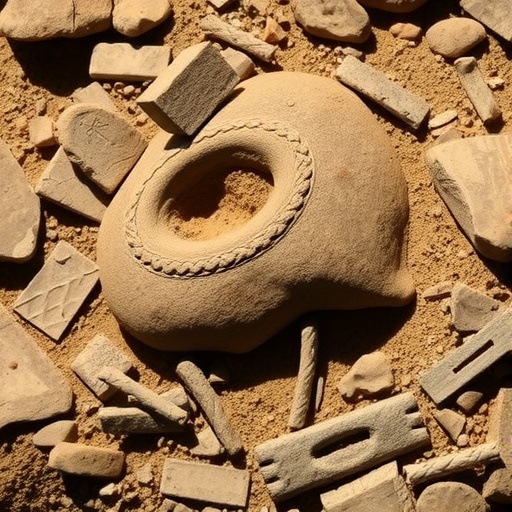The dawn of advanced technology in human history is often associated with leaps seen during the past century; from commercial aviation to nuclear innovations, the moon landing, and the burgeoning internet. However, the pace of technological evolution among our ancient ancestors, the hominins, tells a profoundly different story—one of remarkable stability and enduring ingenuity across hundreds of thousands of years. Recent groundbreaking research published in Nature Communications unravels this narrative of consistency, tracing the use of stone tool technology in East Africa over an astonishing stretch of approximately 300,000 years.
This new study, led by an international team including Amelia Villaseñor, associate professor of anthropology at the University of Arkansas, focuses on a remarkable archaeological site located in the Turkana Basin of Kenya. The site, known as Namorotukunan, harbors three distinct sedimentary layers dated between 2.75 and 2.44 million years ago. These strata provide a continuous record of tool use spanning the Pliocene epoch, capturing a timeline close to the origins of the Oldowan technological tradition—the earliest known stone tool industry characterized by the deliberate flaking of stones to produce sharp-edged cores and flakes.
The persistence of Oldowan tools over such an extensive period—from 2.75 million years ago through 2.44 million years ago—is an extraordinary testament to the adaptive strategies of early hominins. Traditionally, archaeological interpretations emphasize change and innovation as responses to environmental pressures, yet Namorotukunan offers compelling evidence of technical stasis amid significant ecological fluctuations. This challenges prevailing assumptions and speaks to the resilience and efficiency of early lithic technologies.
The succession of environments preserved at Namorotukunan ranges widely—from humid floodplains abundant with palm trees to arid riverine landscapes edging into semi-deserts. Such ecological diversity underscores the magnitude of environmental shifts faced by hominin populations. According to paleoecologist Amelia Villaseñor, the detailed analysis of pedogenic carbonates—tiny carbonate nodules formed from ancient soil processes—enabled the team to infer vegetation patterns, distinguishing grassy landscapes from those dominated by trees. These isotopic proxies are crucial for reconstructing paleoenvironments and contextualizing hominin behavior within fluctuating climatic backdrops.
Further chemical and sedimentological investigations reveal that despite dramatic oscillations—cycles of drought, natural fires, and habitat transformations—ancient populations consistently crafted and utilized Oldowan tools. This technological continuity amidst environmental upheaval illustrates a stable cultural tradition, potentially contributing to hominin survival through challenges that might otherwise have necessitated radical behavioral shifts. The finding that these early toolmakers frequented ancient rivers as predictable ecological resources underscores the strategic use of landscapes in their subsistence practices.
Another fascinating aspect emerging from this multidisciplinary effort is the preferential selection of chalcedony for tool production. This rare, fine-grained, and resilient siliceous rock indicates a deliberate choice, suggesting a refined understanding of material properties. Hominins exhibited considerable skill and knowledge in sourcing and knapping this challenging raw material, reflecting complex cognitive and motor abilities far earlier than often appreciated. The recurring use of such premium materials indicates a sophisticated technological culture maintained over hundreds of millennia.
Direct evidence linking Oldowan tools to dietary behavior includes the discovery of bones bearing cut marks dated around 2.58 million years ago. These butchered remains speak to a pivotal transition toward increased reliance on animal food resources—meat processing using stone tools suggesting enhanced dietary diversity and nutritional strategies. This behavioral milestone may have fueled hominin evolutionary trajectories, influencing morphology, brain expansion, and social organization.
The narrative woven by Namorotukunan’s lithic record highlights a compelling balance: cultural stability coupled with ecological dynamism. Dan V. Palcu Rolier, geoscientist and co-author on the research, describes this as a “declaration of independence,” wherein technology enabled our ancestors to steer their evolutionary course despite environmental flux. Early rivers, serving as lifelines through an aridifying landscape, became focal points for repeated occupation and resource extraction, illustrating the interplay between geography, climate, and culture.
Villaseñor contextualizes the findings within broader eastern African prehistory, noting parallels with Ethiopian sites where the oldest stone tools coincide with arid conditions. The presence of charcoals in sedimentary records, hinting at ancient fires, along with isotopic evidence of drought, underscores the adaptive flexibility of early hominins employing stone tools to exploit available resources effectively. Such adaptability likely played a critical role in their persistence through the unpredictable terrains and climates of the Pliocene.
In aggregate, this study challenges the simplistic narrative of linear technological progression. Instead, it presents a nuanced view where early hominin ingenuity manifested as the long-term refinement, persistence, and selective adaptation of a core technological package tailored to diverse and changing environments. This continuity of cultural tradition over hundreds of thousands of years reshapes our understanding of hominin evolution, emphasizing stability and resilience rather than rapid innovation alone.
Finally, reflecting on the implications for contemporary humanity, Villaseñor suggests that understanding the endurance of early tool use amidst environmental adversity can inform our current perspectives on survival and adaptation. Ancient technologies, though seemingly simple, represent profound problem-solving capacities that helped our ancestors navigate complex ecosystems. This research invites us to draw lessons from the deep past about the enduring human capacity to innovate and thrive in a changing world.
Subject of Research: People
Article Title: Early Oldowan technology thrived during Pliocene environmental change in the Turkana Basin, Kenya
News Publication Date: 4-Nov-2025
Web References: http://dx.doi.org/10.1038/s41467-025-64244-x
Image Credits: University Relations
Keywords: Anthropology, Archaeology




